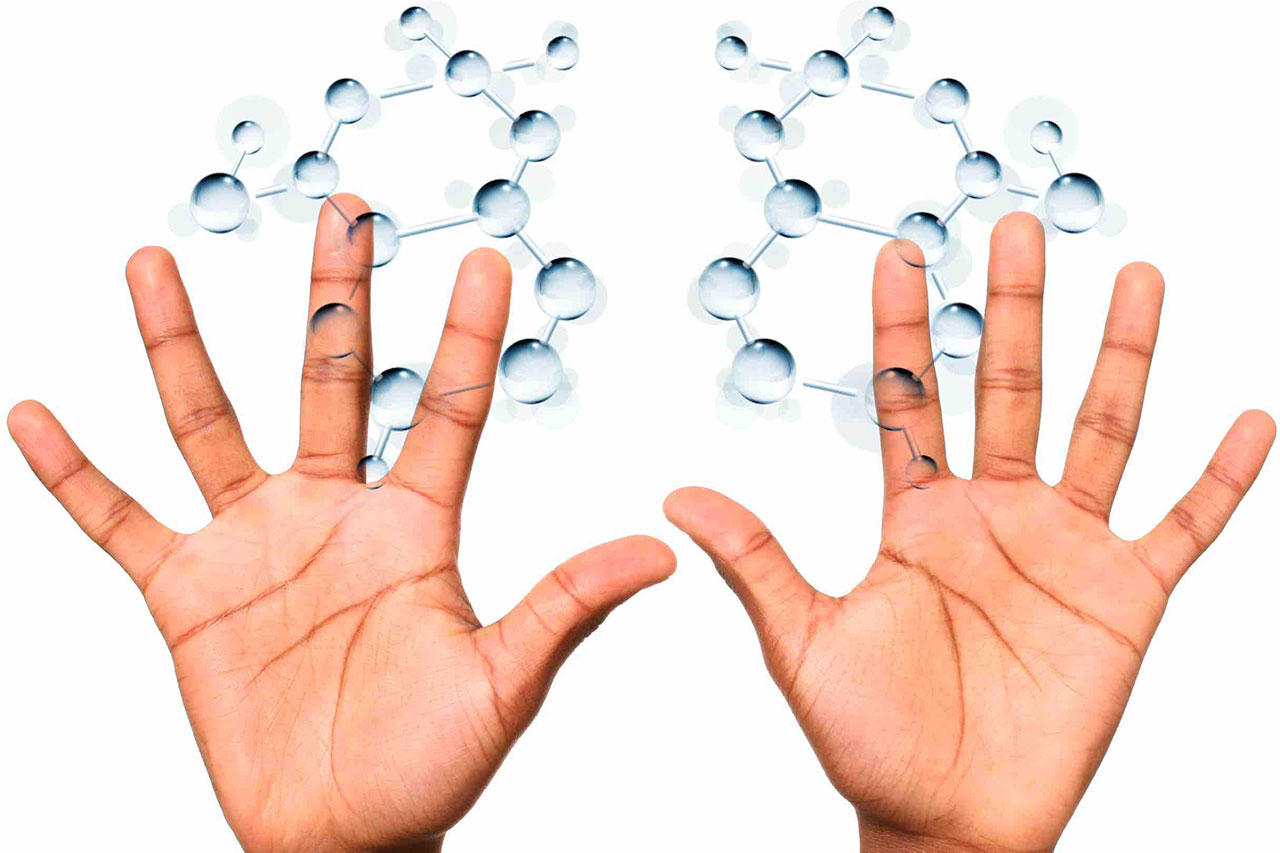One person. Two hands. Left and right. Both are likely to look pretty similar to one another. But look for a little longer, and it is clear that they are not identical. Place one on top of the other and the key difference becomes more obvious: the order of fingers and thumbs is reversed. The two hands are similar, but non-superimposable, images. In other words, they are mirror images of each other.
This concept of being non-superimposable plays an important role in organic chemistry – and particularly in pharmaceutical development.
Molecules are formed of multiple atoms, and can vary in both their molecular formula (the number of each type of atom they contain) and their chemical structure (the way in which these atoms are arranged within the molecule).
Enantiomers share the same formula, but differ in terms of structure.
Same molecule, different effects
Despite this apparent similarity in terms of their formula, enantiomers in a pharmaceutical context can have markedly different effects on the human body.
Take the example of methorphan. One enantiomer (dextromethorphan) is a common cough suppressant that can be used without prescription. Its other enantiomer (levomethorphan) is an extremely strong painkiller.
Another example is Naproxen – a common over the counter drug used for the relief of joint and arthritic pain. Its mirror-image molecule (R-Naproxen) has an identical chemical formula but an inverse chemical structure. This version has no pain-relieving properties, but instead is highly toxic to the liver.
 Given the huge number of molecular entities known to biopharmaceutical science, enantiomers (also referred to as chiral molecules) represent a rich seam of potential new treatments and cures.
Given the huge number of molecular entities known to biopharmaceutical science, enantiomers (also referred to as chiral molecules) represent a rich seam of potential new treatments and cures.
In fact, chiral molecules constitute the majority of small-molecule drugs currently in development, with almost 95% of all drugs expected to be chiral by 2020. Some estimates suggest that the global market for chiral molecules – including pharmaceutical as well as agrochemical, cosmetic and food and beverage applications, among others – was worth $5.1 billion at the start of 2017.
5% of all drugs are expected to be chiral by 2020.
Many of the medicines most used by patients in recent decades have had active pharmaceutical ingredients that are chiral molecules; of particular note are widely used statins such as atorvastatin (also marketed as Lipitor) and simvastatin (also marketed as Zocor). Statins are responsible for averting 80,000 heart attacks every year in the United Kingdom alone, according to a 2016 study in medical journal The Lancet.
Medicines based on enantiomers may sound conceptually simple, but making them is not simply a case of synthesising the mirror image molecule and packaging it up in a pill. As thalidomide has amply shown, one version can be therapeutically beneficial, while its mirror image could be acutely toxic. Exhaustive and expensive clinical trials are therefore needed to identify and delineate any risks to patients.
Developing a new medicine on average takes at least six years of clinical trials, with studies putting the overall cost between $1.2 billion to $2.6 billion.
Medicines based on enantiomers may sound conceptually simple, but making them is not simply a case of synthesising the mirror image molecule and packaging it up in a pill.
Given this expense, it is unsurprising that several important jurisdictions, including the United States, Europe and Australia, generally offer patent protection for enantiomers. The temporary period of market exclusivity afforded by patent rights gives the rights holder a chance to recoup some of this investment, incentivising them to carry out this kind of important research in the first place.
Enantiomer patents under attack
However, the patentability of enantiomers has come increasingly under attack. Critics argue that enantiomers shouldn’t be eligible for patent protection as they lack novelty (or are “obvious”) – a major criteria for patentability.
These arguments are based on the idea that enantiomers are derived simply from ‘flipping’ their already identified chiral partners, and for a person skilled in pharmaceutical R&D, it is obvious to identify and isolate the therapeutically active enantiomer. India, for example, has an unusually high bar for granting patents for enantiomers.
However, such arguments overlook the fact that enantiomers can be both novel and non-obvious – something that has been established by courts in several high-profile patent cases. Two examples are apposite here.
In its 2007 decision on the dispute between Forest Laboratories and Ivax Pharmaceuticals, the US Court of Appeals for the Federal Circuit ruled that just because a racemic mixture existed as prior art – i.e., as evidence predating an invention that might indicate that it is already known – did not mean that the enantiomer purified from that mixture was obvious, because the prior art failed to provide a method for performing the separation that did not require extensive and undue experimentation. The court’s ultimate decision that the enantiomer was nonobvious was also influenced by the fact that the therapeutic properties of the isolated enantiomer significantly exceeded those of the known racemic mixture.
As top courts have recognised, isolating enantiomers is far from a simple case of holding the molecule up to a mirror and noting down the difference in structure.
In 2008, a validity challenge by Canadian generic company Apotex against patents for Sanofi’s anti-coagulant drug clopidogrel reached the Supreme Court of Canada. Experts testifying for both parties agreed that the separation of enantiomers in racemic mixture is an extremely technically difficult proposition. The high degree of similarity between the two enantiomers makes it very challenging to separate them from each other, the experts observed. Further, the safety and efficacy of the enantiomer greatly exceeded reasonable expectations, the Court concluded.
They also agreed that, since there is no general methodology for separating enantiomers, the separation of each racemic mixture must be solved through trial-and-error on a case-by-case basis – in other words, at great expense and significant commercial risk to the research teams, companies and investors involved.
As top courts have recognised, isolating enantiomers is far from a simple case of holding the molecule up to a mirror and noting down the difference in structure.
Patents necessary to encourage R&D
Experimentation is required to begin to understand the medical effects of the enantiomer; often, there will be no significant difference to the racemic mixture – or there will be no effect at all. Separating out a racemic mixture can prove a painstaking process. Then clinical trials will need to be conducted to ascertain the efficacy and safety of the enantiomer. The risks in funding and conducting enantiomer research are high; but the rewards can be too, since every so often one forms the basis for a revolutionary new treatment.
Unless we wish to see less experimentation and innovation in this important class of pharmaceutical invention, patents for enantiomers should continue to be made available by intellectual property authorities around the world.



